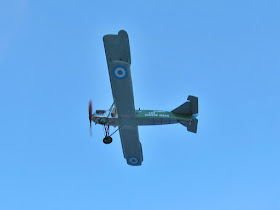A civil plane, in spite of its cockades (as explained below), the Fokker C.IV C was one of the protagonists of a rather eventful world-renowned saga.
(I am replicating here the text written for the seaplane version, as it's pertinent to both models).
Here is the step-by-step building article:
https://wingsofintent.blogspot.com/2019/01/around-world-pedro-zannis-fokker-civ.html
And here is the seaplane version model completed:
https://wingsofintent.blogspot.com/2020/12/fokker-civ-w-pedro-zanni-around-world.html
A country at the southern tip of South America, still partially in its agricultural/ranching-economy slumber, far away from the hubs of financial power and technology, dared to dream of an almost mythical feat: to circumnavigate the world by airplane, in 1924. The dream proved bigger than the available resources, and in spite of strong popular support, certain dose of chivalry, and a number of strong wills put together, the dream ended up sinking, literally, in Tokyo Bay, a long time after departing east-bound from Amsterdam. A Fokker C.IV and a C.IV W planes were involved, a third reputedly left in storage in Canada as a replacement for the last leg of the attempt, that a source states was a low wing Fokker T.IIIW. The two Fokker C.IV were the landplane Ciudad de Buenos Aries and the seaplane Provincia de Buenos Aires. Of the three crew members that were initially chosen to fly, only two would do the trip: pilot Pedro Zanni and mechanic Felipe Beltrame; the third, Nelson Page, that was supposed to be the navigator, having fallen ill.
Zanni's strong desire to accomplish the task may have led to some questionable piloting decisions involving weather judgment that cost him his first plane -demolished in China- and eventually the second, seen sadly in photos ignominiously half-submerged in the water sticking its tail up. Many accounts veil the final shame, and state that Zanni "decided to abandon the enterprise due to weather and financial concerns". All this, as said, after a series of mishaps involving possible misjudging of terrain and weather. It could be argued that you can't fly a plane only with your will and bravery, you also need a cool mind, and a knowledge, financial and technical support, and skill comparable to the enterprise you want to tackle. Be that as it may, Zanni and Beltrame made a prodigious journey, again considering their lack of resources and feeble tactical support. And so Argentina was for a while featured in newspapers that followed the progress of these commendable men. For some reason, it was decided to keep the standard factory finish, catering for the military market, as we know an absolutely terrible choice for a civil flight if an emergency occurred, when finding and rescue may have been impaired by that standard camouflage. The plane wore the country's cockades and rudder colors, not necessary -or perhaps not even legal- as the plane did not belong to the Argentinean military, nor was it sponsored by it, if indeed the pilot was an active military pilot. The fact that was paid be popular collect and sponsored by the Aero Club Argentino (a civil entity) is the reason I decided to build these planes, as there was no military ownership or sponsorship, and the planes of course were exclusively used for (and spent in) this around the world flight attempt.
As stated in the building article, this is a project we took up together with my older son, also a modeler, and decided to build one of them each. At one point it was obvious that many mods were needed and the kit was extremely poor (to say the very least), so I was supposed to build mine and prepare an "improved and modified kit" for him to build, to save him time. Well, guess what, daddy ended up building both and gifting one to the son, as son became a father himself in the interim with additional responsibilities and certain restrictions regarding modeling time, and daddy became a grandfather. Still, each of us will have now one of these twins on display, which is, after all, very nice.
I (almost) always enjoy working on basic kits aspiring to make of them more accurate and better detailed replicas, but there are limits to that approach. In this case the kit was so lacking that it would have been immensely easier (not to mention more satisfying) to scratch the two models from the start, instead of having to deal with re-working almost every part of it, in part of course to obtain a different version, but mostly because the parts were so poor to start with.
The two planes, for land and sea, were the same plane, but not completely identical: besides the obvious landing/alighting equipment, other small differences are present.
On top of that, the machines changed details as they progressed in their trip, with differences most notably on their noses. As usual, one version has to be chosen for the model, in this case the machines as they were in their last legs (figuratively and literally) of the trip.
It is of note that Zanni's -that news agencies often spelled "Zani"- flight was contemporary of that of the USA pilots in their four Douglas World Cruisers, that even counting with vastly superior support -technical and financial-, had nonetheless their fair share of serious difficulties.
It's not surprise then that Zanni and Beltrame had to
abandon their enterprise midway, and yet still they were hailed -and fairly so-
as heroes in their native country.
The two machines, used consecutively, in the around the world flight attempt:
Some articles with varied information, a few bits of it not totally accurate (Zanni dismissed Italian and British plane, and ended up adopting Fokker's):






















































This is a wondrous thing.
ReplyDeleteEnough to make me sing
You’re the 1/72 scale king.
Kind of you, sir!
ReplyDeleteAnother MoaMiniatureMasterpiece!
ReplyDeleteYou are very kind, Michael!
DeleteMi abuelo felipe beltrame
ReplyDelete